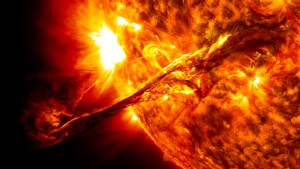
You might not know that the Sun is actually a star, which the Earth and other planets orbit around. A glowing ball of plasma, the Sun is a gaseous state of matter. This plasma ball’s surface temperature is over 9,900° Fahrenheit!
Because the Sun is so bright and hot and contains gases, it has no solid surface. At the core of this star, hydrogen changes into helium through a chain of thermonuclear reactions. This makes the Sun shine brightly by generating heat. This chain of reactions also creates intense outward pressure that balances with the Sun’s strong gravitational pull.
Born about 4.6 billion years ago, the Sun has an interior made up of three zones. The innermost zone, the core, takes up approximately 20 percent of the Sun’s radius. The second is the radioactive zone, which extends to 70 percent of the solar radius. The third, the convective zone, is the outermost zone and spans 30 percent of the Sun’s radius. Here, gas is heated by the radioactive zone below and rises in convection cells to the star’s surface, where it spreads out and cools before sinking again.
Overall, the Sun is about 9.7 times the diameter of Jupiter, which is approximately 11.7 times the size of Earth. This huge star takes 35 days on average to spin once at the poles, but only 25 days—give or take a few—to spin at the equator.
Like all stars, the Sun will eventually burn out and die. But we don’t need to worry about this happening in our lifetime. Scientists predict that it will continue to burn for another six billion years before running out of hydrogen!
[Sources:
NASA; Atlas of the Universe
]

